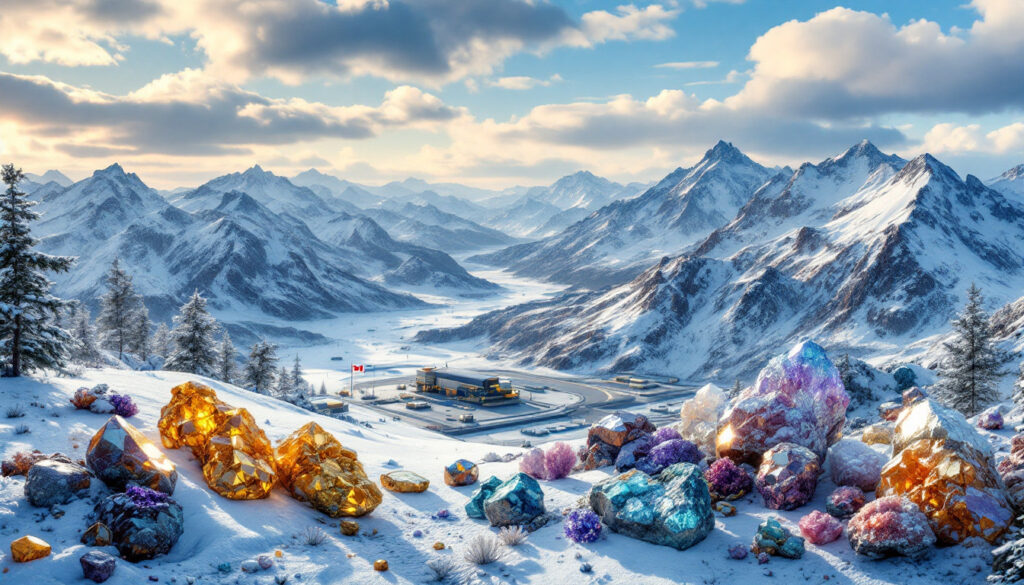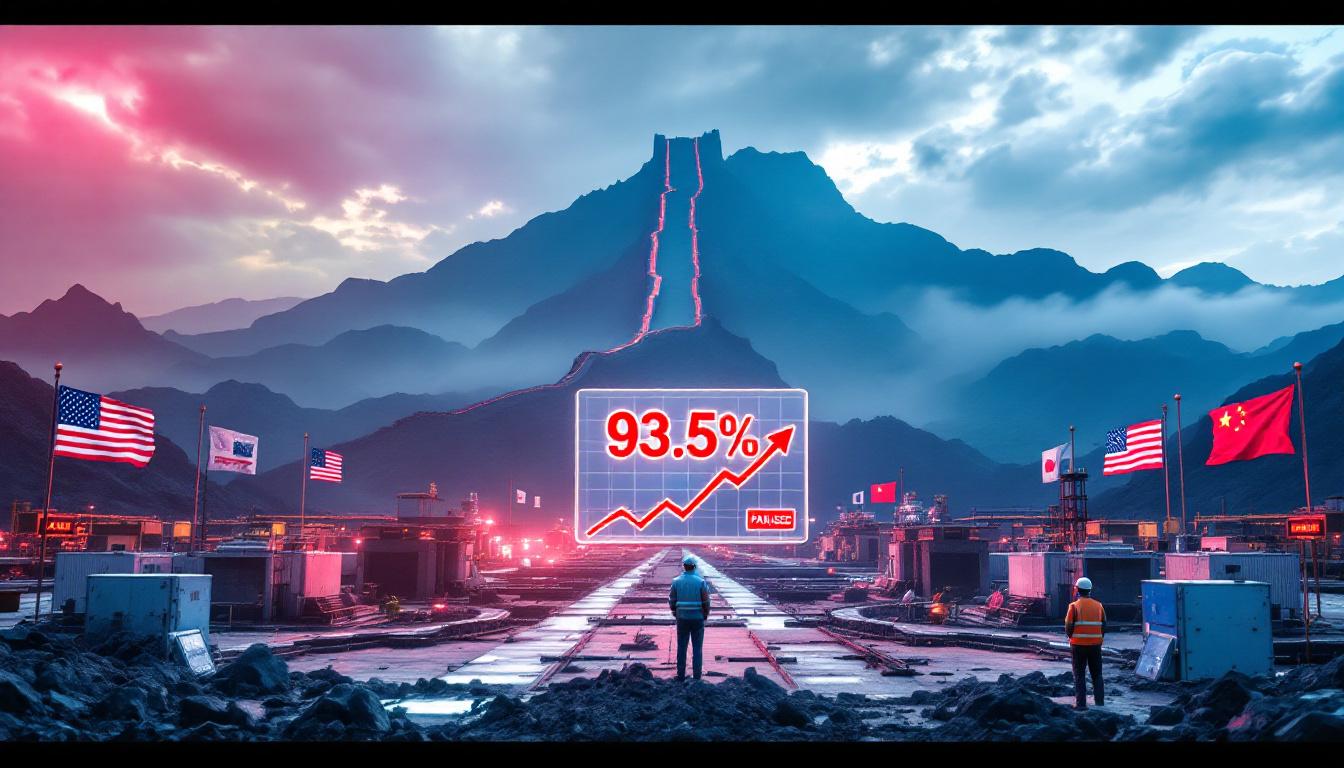What Makes the Northwest Territories a Strategic Mining Jurisdiction?
The Northwest Territories (NWT) has emerged as one of Canada's most significant mining regions, positioned strategically in the global critical minerals market. This vast northern territory is rapidly gaining recognition for its exceptional mineral wealth and growing importance to North American supply chain security.
Federal Investment and Economic Importance
Mining forms the backbone of the Northwest Territories' economy, contributing approximately one-third of the region's GDP. Recognizing this economic importance, the Canadian government recently announced a C$420,000 (A$467,033) federal investment at the PDAC conference through the Canadian Northern Economic Development Agency (CanNor).
This investment reflects a concerted effort by both federal and territorial governments to position the NWT as a major contributor to critical minerals supply security in an increasingly competitive global market. Furthermore, these initiatives are crucial for addressing critical mineral shortages in the clean energy transition.
Rich Mineral Diversity
The Northwest Territories boasts an impressive mineral portfolio that extends far beyond its status as the world's third-largest producer of diamonds. The territory contains 12% of global bismuth reserves and hosts confirmed deposits of lithium, cobalt, copper, nickel, and rare earth elements – all critical components for green technology and energy transition.
Particularly noteworthy is the Great Bear Magmatic Zone (GBMZ), which geological surveys have identified as having the highest probability in Canada for hosting large-scale Iron Oxide Copper Gold (IOCG) deposits and uranium mineralization. The GBMZ represents one of North America's most promising yet underexplored mineral provinces, with geology conducive to understanding the formation and economic impact of porphyry and epithermal deposits.
How Is Canada Positioning the Northwest Territories in the Global Minerals Market?
Critical Minerals Strategy
Canada's federal government has demonstrated strong backing for northern mining sector development as part of its comprehensive Critical Minerals Strategy. The territorial governments of Yukon, Northwest Territories, and Nunavut have coordinated their promotional efforts to attract investment to their resource-rich regions.
This coordinated approach focuses on resource development as a key economic growth driver while positioning these territories to address the growing global demand for minerals essential to green technology. The strategy includes streamlined permitting processes and enhanced geological data collection to de-risk exploration investments.
Supply Chain Security
The Northwest Territories is rapidly emerging as a vital player in the global critical minerals supply chain, particularly as geopolitical tensions highlight vulnerabilities in current supply networks. The territory has the potential to establish North America's first domestic bismuth supply chain – a prospect whose strategic importance was dramatically heightened by China's recent export controls on bismuth implemented in February 2025.
These developments have attracted substantial government support for critical mineral projects across the Northwest Territories. Both the Canadian and American governments have recognized the strategic importance of navigating the global critical minerals race amidst resource nationalism to reduce dependence on foreign sources of critical minerals.
What Are the Northwest Territories' Most Significant Mineral Projects?
Bismuth and Polymetallic Deposits
Fortune Minerals' NICO project stands as one of the territory's most promising mineral developments. This advanced-stage project contains a substantial resource of 33.1 million tonnes with impressive polymetallic content: 1.1 million ounces of gold, 82.3 million pounds of cobalt, 102.1 million pounds of bismuth (representing 12% of global reserves), and 27.2 million pounds of copper.
With a potential 20-year mine life, the NICO project has attracted C$7.5 million in support from Natural Resources Canada and an additional $6.38 million from the US Department of Defense specifically for developing cobalt production capabilities. This cross-border support underscores the strategic importance of the project to North American mineral security.
Rare Earth Elements
Vital Metals' Nechalacho project is positioned to become Canada's first rare earths mine, representing a significant milestone for the domestic critical minerals sector. The project's Tardiff deposit contains an impressive 192.7 million tonnes at 1.3% total rare earth oxide (TREO), including 636,000 tonnes of neodymium-praseodymium (NdPr) and 578,100 tonnes of niobium pentoxide.
A comprehensive scoping study is planned to examine various size and scalability options for production scenarios. The project's development timeline has accelerated in response to growing demand for rare earth elements in high-tech applications and the need to establish supply chains independent of Chinese dominance.
Copper and Precious Metals
White Cliff Minerals' Great Bear Lake project is targeting copper, gold, silver, and uranium in a region with an impressive production history. Historical mining in the area has produced 13.7 million pounds of U₃O₈, 34.3 million ounces of silver, and 11.4 million pounds of copper with gold credits, plus nickel, cobalt, and lead by-products.
The project area covers some of the most prospective yet underexplored terrain within the Great Bear Magmatic Zone, with geological similarities to world-class mining districts in Australia and other parts of Canada. Investors interested in such projects should consider navigating risks and rewards in junior mining investments to make informed decisions.
What Recent Exploration Activities Are Occurring in the Region?
White Cliff Minerals' Great Bear Project
White Cliff Minerals has established an exploration agreement with the Délınę Got̨'ınę First Nations government, demonstrating the importance of indigenous partnerships in northern resource development. The company secured a free one-year extension to all permits until January 2028, providing extended runway for exploration activities.
The project encompasses 2,900 square kilometers within the highly prospective Great Bear Magmatic Zone and is located 240 kilometers southwest of the company's Rae project in Nunavut. This strategic positioning allows for operational synergies across the company's northern Canadian portfolio.
Recent Exploration Results
Recent exploration activities have yielded promising results. A Mobile Magnetotellurics (MobileMT) survey identified four large IOCG hydrothermal systems, highlighting the potential for significant mineralization. The maiden fieldwork program confirmed widespread high-grade mineralization, including exceptional samples of 42.6% copper and 38.2g/t gold from the Phoenix prospect.
Additionally, samples from the Slider prospect returned 7.54% silver and 5.35% silver, representing the highest-grade silver rock chip assay in the region's recent history. These results have informed plans for a drilling campaign later in 2025, following receipt of interpreted MobileMT data.
How Has the Global Market Affected Mineral Development in the Region?
Bismuth Market Dynamics
The bismuth market has experienced dramatic changes, with prices increasing more than six-fold since January 2025. This surge followed China's implementation of export controls in February 2025, which severely disrupted global supply chains. The situation highlights the vulnerability of current supply networks, given that China controls approximately 90% of global refined bismuth production and around 80% of global bismuth mining.
These market dynamics have created a significant opportunity for the Northwest Territories to establish itself as an alternative supply source. The territory's substantial bismuth reserves position it to capitalize on these changing market conditions and satisfy growing North American demand.
Critical Minerals Demand
The global transition toward green technologies is driving unprecedented demand for critical minerals. Battery minerals such as lithium, cobalt, and nickel are experiencing particularly strong growth trajectories due to the expansion of electric vehicle manufacturing and energy storage systems.
Rare earth elements, essential for permanent magnets used in wind turbines, electric motors, and electronics, face similar demand pressure. The Northwest Territories' diverse mineral endowment positions it perfectly to meet North American demand across multiple critical mineral categories, particularly as manufacturers seek more secure and transparent supply chains.
What Challenges and Opportunities Exist for Mining Companies?
First Nations Engagement
Successful resource development in the Northwest Territories requires meaningful engagement with Indigenous governments. White Cliff's agreement with the Délınę Got̨'ınę First Nations serves as a positive example of collaborative approaches to exploration and development.
These partnerships can provide sustainable economic benefits for local communities while ensuring responsible resource development. Companies that excel at indigenous engagement gain significant advantages in permitting, local workforce development, and social license to operate.
Infrastructure and Logistics
The remote location of many Northwest Territories mining projects presents significant logistical challenges. Transportation infrastructure development remains a critical need, particularly as projects move from exploration to production phases.
Seasonal access considerations in the northern climate add complexity to project planning and execution. However, these challenges also present opportunities for government support through infrastructure development programs designed to enhance northern economic development and critical minerals security. Industry participants can benefit from discovering cutting‐edge mining investment strategies and geological insights to navigate these challenges effectively.
FAQ: Mining in Canada's Northwest Territories
What critical minerals are found in the Northwest Territories?
The Northwest Territories contains significant deposits of bismuth (12% of global reserves), rare earth elements, copper, gold, silver, uranium, lithium, cobalt, nickel, and diamonds. This diverse mineral portfolio positions the territory as a crucial contributor to North America's critical minerals supply chain. The Northwest Territories mining industry continues to grow with new discoveries.
How significant is mining to the Northwest Territories' economy?
Mining contributes approximately one-third of GDP in Canada's northern territories, making it the backbone of the regional economy. The sector provides high-wage employment opportunities and supports substantial indirect economic activity through service and supply chain businesses.
What government support exists for mining in the Northwest Territories?
Federal support includes a C$420,000 investment through CanNor, plus project-specific funding such as C$7.5 million for Fortune Minerals' NICO project from Natural Resources Canada and $6.38 million from the US Department of Defense. These investments reflect the strategic importance of Northwest Territories mining to national security and economic development.
How does the Northwest Territories compare to other mining jurisdictions?
The Northwest Territories is the third largest global producer of diamonds and holds 12% of the world's bismuth reserves, positioning it as a globally significant mining jurisdiction with substantial untapped potential. Its geological similarity to productive mining regions worldwide suggests considerable opportunity for future discoveries, particularly in the underexplored Great Bear Magmatic Zone. The territory's Diavik Diamond Mine is one of the most significant diamond producers in North America.
Want to Stay Ahead of the Next Major Mineral Discovery?
Discovery Alert's proprietary Discovery IQ model delivers instant, actionable insights on significant ASX mineral discoveries, turning complex mining data into opportunities for both short-term traders and long-term investors. Explore why major mineral discoveries can lead to substantial returns by visiting our dedicated discoveries page and begin your 30-day free trial today.




